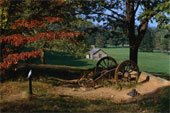War, ugh...what is it good for? Conservation

Regular readers of this blog (yes both of you) know that in addition to having a thing for the environment, I have a thing for history.
Back on Sept. 12, in a blog titled The Historical Park Paradox, I wrote about the conflict between my desire to see a Revolutionary War Museum at Valley Forge Park, and concerns about the accompanying convention center and what might be destroyed by its construction.
Twelve days later, all 435 members of the House of Representatives obviously being regular readers of The Thin Green Line, the House passed two important battlefield protection bills furthering efforts to protect battlefields of the Revolutionary and Civil wars.
HR 2933, sponsored by U.S. Rep. Gary Miller, a Republican from California, reauthorizes the Civil War Battlefield Protection Program by extending it until FY 2013. Without the legislation, the program would have expired at the end of the federal fiscal year, Sept. 30.
According to The Trust for Public Land, "the program, administered by the National Park Service, is authorized to spend $10 million annually from the Land and Water Conservation Fund, subject to congressional appropriation, to protect Civil War battlefields that are located outside of the boundaries of existing national park units. According to House Report 110-792 accompanying the bill, $26.3 million in federal funds from the program have been leveraged with $52 million in non-federal funds to protect more than 15,700 acres at 72 Civil War battlefield sites. An identical measure, S 1921 was sponsored by Sen. Jim Webb, a Democrat from Virginia. The program has broad bipartisan support in Congress, as 107 representatives and 32 senators from around the country have cosponsored the legislation."
Certainly this could be used in Pennsylvania's own Gettysburg National Park, where one in five acres is private owned.
And not to be Civil War-centric, a similar bill has also been proposed for the two warts that proceeded it.
HR 160, sponsored by U.S. Rep. Rush Holt, a Democrat from New Jersey, creates the Revolutionary War and War of 1812 Battlefield Protection Program. The potential program is modeled after the Civil War Battlefield Protection Program.
HR 160, sponsored by U.S. Rep. Rush Holt, a Democrat from New Jersey, creates the Revolutionary War and War of 1812 Battlefield Protection Program. The potential program is modeled after the Civil War Battlefield Protection Program.
Under the bill, state and local governments, in partnership with non-profit organizations, may apply to the National Park Service for one-to-one federal matching grants to acquire fee or easement interests in land to preserve battlefield sites related to the two wars.
Given that fact that much of the land around Valley Forge about which so much consternation is expressed is in private hands. This might be a vehicle to change that. Of course in this economy, with the state budget in tatters, finding funds could be next to impossible.
On the other hand, if funds were found it would be hard to find a better real estate market in which to buy.
The sites must be outside the boundaries of existing national park units and must be listed in a National Park Service study presented to Congress in September 2007.
This report was authorized by Congress back in 1996. Annual funding of $10 million from the Land and Water Conservation Fund, subject to congressional appropriation, is authorized until FY 2013.
The 2007 report to Congress identified 677 sites associated with the two wars. As many as 335 sites, nearly half of the total, were found to be lost, destroyed, or extremely fragmented.
The 2007 report to Congress identified 677 sites associated with the two wars. As many as 335 sites, nearly half of the total, were found to be lost, destroyed, or extremely fragmented.
According to House Report 110-796 accompanying the bill, "urbanization, suburban sprawl, and unplanned commercial and residential development have increasingly encroached upon these battlefield sites, threatening their historical integrity and even resulting in the loss of some sites altogether," according to the Trust for Public Land.
Both bills await action in the Senate.
Both bills await action in the Senate.
Hmmmm, perhaps we shouldn't hold our breath...
Labels: Gettysburg, Trust for Public Land, Valley Forge
 RSS
RSS


1 Comments:
Open space is good for humans. The quality of life goes down in an inverse relationship to the amount of concrete poured over what used to be open space.
Post a Comment
<< Home